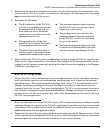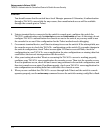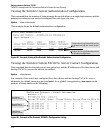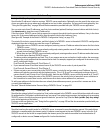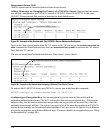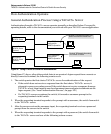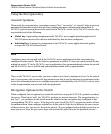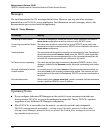
178
Enhancements in Release F.02.02
TACACS+ Authentication for Centralized Control of Switch Access Security
Name Default Range
host <ip-addr> [key <key-string> none n/a
Specifies the IP address of a device running a TACACS+ server application. Optionally, can also specify the unique, per-
server encryption key to use when each assigned server has its own, unique key. For more on the encryption key, see
“Using the Encryption Key” on page 183 and the documentation provided with your TACACS+ server application.
You can enter up to three IP addresses; one first-choice and two (optional) backups (second-choice and third-choice).
Use show tacacs to view the current IP address list.
If the first-choice TACACS+ server fails to respond to a request, the switch tries the second address, if any, in the show
tacacs list. If the second address also fails, then the switch tries the third address, if any.
(See figure 84, "Example of the Switch’s TACACS+ Configuration Listing" on page 173.)
The priority (first-choice, second-choice, and third-choice) of a TACACS+ server in the switch’s TACACS+ configuration
depends on the order in which you enter the server IP addresses:
1. When there are no TACACS+ servers configured, entering a server IP address makes that server the first-choice
TACACS+ server.
2. When there is one TACACS+ serves already configured, entering another server IP address makes that server the
second-choice (backup) TACACS+ server.
3. When there are two TACACS+ servers already configured, entering another server IP address makes that server
the third-choice (backup) TACACS+ server.
• The above position assignments are fixed. Thus, if you remove one server and replace it with another, the new server
assumes the priority position that the removed server had. For example, suppose you configured three servers, A, B,
and C, configured in order:
First-Choice:A; Second-Choice:B; Third-Choice: C
• If you removed server B and then entered server X, the TACACS+ server order of priority would be:
First-Choice:A; Second-Choice:X; Third-Choice: C
• If there are two or more vacant slots in the TACACS+ server priority list and you enter a new IP address, the new
address will take the vacant slot with the highest priority. Thus, if A, B, and C are configured as above and you (1)
remove A and B, and (2) enter X and Y (in that order), then the new TACACS+ server priority list would be X, Y, and C.
• The easiest way to change the order of the TACACS+ servers in the priority list is to remove all server addresses in
the list and then re-enter them in order, with the new first-choice server address first, and so on.
To add a new address to the list when there are already three addresses present, you must first remove one of the
currently listed addresses.
See also “General Authentication Process Using a TACACS+ Server” on page 181.
key < key-string > none (null) n/a
Specifies the optional, global "encryption key" that is also assigned in the TACACS+ server(s) that the switch will access
for authentication. This option is subordinate to any "per-server" encryption keys you assign, and applies only to accessing
TACACS+ servers for which you have not given the switch a "per-server" key. (See the host <ip-addr> [key <key-string>
entry at the beginning of this table.)
For more on the encryption key, see “Using the Encryption Key” on page 183 and the documentation provided with your
TACACS+ server application.
timeout < 1. . 255 > 5 sec 1 - 255 sec
Specifies how long the switch waits for a TACACS+ server to respond to an authentication request. If the switch does
not detect a response within the timeout period, it initiates a new request to the next TACACS+ server in the list. If all
TACACS+ servers in the list fail to respond within the timeout period, the switch uses either local authentication (if
configured) or denies access (if none configured for local authentication).



